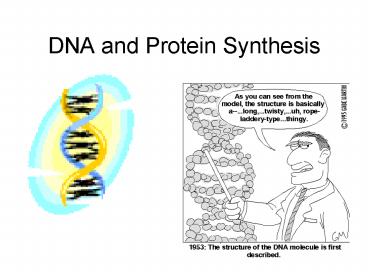DNA and Protein Synthesis - PowerPoint PPT Presentation
1 / 53
Title:
DNA and Protein Synthesis
Description:
Control the processes of heredity by which cells and organisms make proteins. ... type and structure, it's time to start building the polymer from these monomers. ... – PowerPoint PPT presentation
Number of Views:138
Avg rating:3.0/5.0
Title: DNA and Protein Synthesis
1
DNA and Protein Synthesis
2
Nucleic Acids
3
Nucleic Acids - Function
- Control the processes of heredity by which cells
and organisms make proteins.
4
Nucleic Acids Types
- DNA
- Deoxyribonucleic Acid
- RNA
- Ribonucleic Acid
5
As you know, DNA stands for.
DEOXYRIBONUCLEIC ACID
6
Is DNA a monomer or polymer
- Monomer
- Polymer
1 2 3 4 5 6 7 8 9 10 11 12 13 14 15 16 17 18 19 20
21 22 23 24
7
The monomer units of DNA are known as.
NUCLEOTIDES
8
All nucleotides have three parts in common.
They all contain.
9
PLEASE UNDERSTAND, A NUCLEOTIDE IS A VERY COMPLEX
STRUCTURE. IF WE REPRESENTED ALL OF THE ATOMS,
IT WOULD LOOK LIKE THIS
10
We will use our hands to represent a nucleotide.
11
The four different Nitrogen Bases for DNA are
abbreviated using the following letters.
Adenine
Thymine
Guanine
Cytosine
12
Using your two hands, please show how you think
two nucleotides will/should bond together.
Did you put your hands like this???
13
In DNA, Adenine always pairs with Thymine using
two hydrogen bonds.
14
A AND T AT THE ATOMIC LEVEL
15
In DNA GUANINE always pairs with CYTOSINE using
three hydrogen bonds.
16
G AND C AT THE ATOMIC LEVEL
17
THE ENTIRE MOLECULE AT THE ATOMIC LEVEL
18
Time to use your brain and hands in order to
review nucleotide structure and type.
USING YOUR HAND, SHOW ME THYMINE
USING YOUR HAND SHOW ME ADENINE
SHOW ME CYTOSINE
SHOW ME HOW CYTOSINE AND THYMINE BOND
TO FORM A RUNG ON THE LADDER
THEY DONT
19
OK Now that you recognize nucleotide type and
structure, its time to start building the
polymer from these monomers.
20
In order to make a molecule of DNA, you would
need to create many rungs to the DNA ladder.
Look. Many Rungs.
Etc
21
What part of the nucleotide alternates to form
the sides of the DNA ladder?
Etc
22
What makes up the RUNGS of the ladder?
23
Go Ahead! Stack your hands on top of your
partners hands building two rungs of the DNA
ladder.
24
TRY IT!!!
25
If you link enough nucleotides together, the DNA
molecule begins to take on the characteristic
shape known as the
Double Helix
26
Lets make a candy version of our DNA
27
Lets Review First
- Nucleic Acid
- Nucleotide
- DNA
- RNA
- Nitrogen Base
- Double Helix
28
Nucleic Acid Structure
- Made up of a chain of Nucleotides that contain
- Phosphate backbone
- Sugar
- Nitrogen base
- Guanine
- Cytosine
- Adenine
- Thymine (Found only in DNA)
- Uracil (Found only in RNA)
29
Nucleic Acids
30
DNA
31
DNA
SUGAR
Phosphate
32
Lets see how well you looked at the
diagramregarding the nitrogen bases, Adenine
always bonds with which one?
- Cytosine
- Thymine
- Guanine
- Uracil
1 2 3 4 5 6 7 8 9 10 11 12 13 14 15 16 17 18 19 20
21 22 23 24
33
DNA
SUGAR
Phosphate
34
Lets make a candy version of our DNA
35
Candy DNA
- Pipe cleaner for the form
- Red Twizzler Deoxyribose
- Black Twizzler Phosphate
- Colored Marshmallows nitrogen bases
36
Candy DNA
- Colored Marshmallows Nitrogen Bases
- Pink Marshmallow Adenine
- Green Marshmallow Thymine
- Yellow Marshmallow Cytosine
- Orange Marshmallow Guanine
- Well use toothpicks to join the nitrogen bases
to the sugar
37
Lets Build
38
What actual structures make up the sides of the
ladder?
- Deoxyribose sugar
- Phosphate
39
What structures make up the rungs?
- Nitrogen Bases
40
What do you notice about all the DNA molecules in
the room?
- They are all different!
41
DNA Replication
- 1.) DNA unzips
- 2.) Free nucleotides bond with open
complementary base pairs - 3.) 2 new strands formed
42
(No Transcript)
43
Lets review DNA
44
Lets Build A Protein
45
Protein Synthesis
- Its a process
- DNA -gt RNA -gt Amino Acids (Protein)
46
RNA
- Sugar is Ribose NOT what
- Has nitrogen base Uracil instead of Thymine
- Also contains the other 3 baseswhat are they?
- Only single stranded
47
RNA
48
Transcription
- 1.) DNA strand unzips
- The bonds between the nitrogen bases are broken
- 2.) A single strand of mRNA (messenger RNA) is
made - Pair up the bases
- 3.) mRNA travels from nucleus to cytoplasm
49
Transcription
50
Why is mRNA called messenger RNA?
- Because it carries the directions to make a
protein to the ribosome like a message
51
Translation
- mRNA meets up with a ribosomewhy??
- tRNA molecules bring amino acids to ribosomes
- An mRNA codon will pair with a tRNA anticodon
- Codon 3 Nitrogen base sequence in mRNA that
specifies a specific amino acid - Anticodon 3 Nitrogen base sequence in tRNA
- As tRNAs are added, amino acids are bonded
together and will be released as a fully
functional protein.
52
Translation
53
Thats the process, Now how do you know what
amino acids make up a particular protein
- We use an mRNA codon chart





























